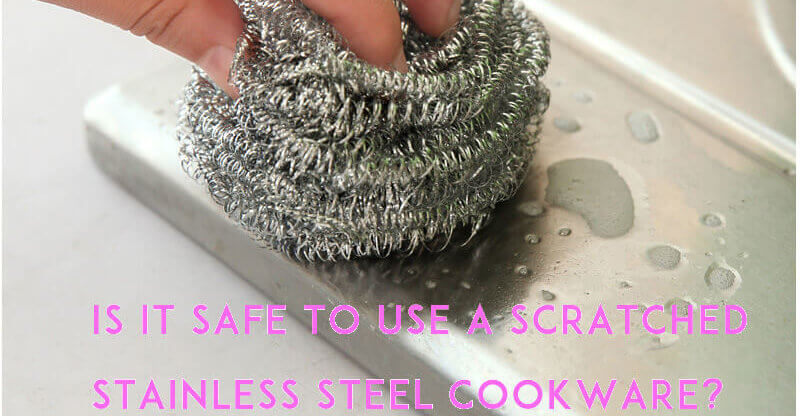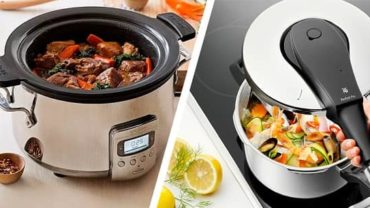Is it safe to use a scratched stainless steel cookware?
Probably the most popular cookware material, stainless steel is a strong and relatively safe metal to be used in utensils and other cooking-related tools and appliances. However, even though it’s a safer choice, it doesn’t mean stainless steel comes with zero health risk if you don’t know how to use it properly and in which case you should stop using it completely.
Like other common materials such as aluminium and cast iron, there’s a right and a wrong way when it comes to using stainless steel cookware. For instance, many wonder whether it is safe to use a scratched stainless steel saucepan. Today in this article we are going to explain if the stainless steel is really as safe as we commonly think, or it can be harmful to use for cooking when it’s damaged or scratched. So without further ado, let’s get started.
A few words of caution: Don’t conclude anything or be freaked out and go for a shopping frenzy replacing all of your cookware made from stainless steel until you go through the entire article. The purpose of this article is not fear-mongering, instead, only to serve you with cold hard facts about how to use stainless steel cookware safely and nothing else.
The Difference of Quality in Stainless Steel
Table of Contents

Regardless of how weird it sounds, not every stainless steel cookware in your home is made from the same quality materials. People very rarely consider metal and build quality when they buy kitchenware; whether it’s a copper, silicone, or stainless steel is all they care about. However, like every other material, stainless steel comes in a vast range of types and grades as well depending on its composition, quality, temperature resistance, and durability.
Typically the highest quality stainless steel is used to manufacture surgical tools; hence that specific grade of stainless steel is often known as surgical steel. One should buy cooking utensils made using this particular grade of stainless steel to ensure safe meals every day that are not contaminated with toxic materials for a longer period.
The benefits of using surgical stainless steel cookware
Surgical stainless steel, which is often called marine stainless steel (as it’s used to manufacture ships to withstand the harshest of sea weathers all year long) comes with grade 316. This is the same grade steel many kitchen brands use to manufacture their cookware. The difference between surgical steel and the other lower graded ones is in their compositions.
Surgical stainless steel alloy contains a little amount of titanium or molybdenum, making it more resistant to corrosion and rust compared to a lower 304-grade stainless steel. The cookwares which are constructed using surgical stainless steel tend to be on the expensive side, but you’re ensured to get the top-notch quality that will outlast the rest.
Is it safe to use a scratched stainless steel pan?

Before answering this question, you need to know what is stainless steel exactly. Steel is primarily an alloy made from a composition of mostly iron with a little carbon. Iron, in its own, is prone to rust; therefore when steel uses carbon to form the alloy which is less prone to rust. Stainless steel is an advanced type where apart from iron and carbon, some other heavy metals including nickel and chromium are added to make a reliable and durable final product which is a great deal more corrosion-resistant.
Now, while stainless steel is an amazing material for any kind of cookware, it leaches nickel to the food, which is not good news for our health. This is especially prevalent if you are cooking any acidic food. Almost 10% of people, more commonly women than men, experience “contact dermatitis” when they get exposed to heavy metal like nickel. Women sometimes get rashes and irritations when they wear cheap earrings as those are made of nickel generally.
Nickel is not required by our body, not even the slightest. In fact, it has many toxic effects on our body and therefore our physical system needs to get rid of it as soon as we get exposed to any amount of the same. Otherwise, that can add up to result in heavy metal poisoning over time. That being said, it’s extremely rare to have heavy metal poisoning only due to use of stainless steel cookware, at least not yet proved with enough data.
According to a report published in the Journal of Agricultural and Food Chemistry, it is found that stainless steel cookware can leach some amount of nickel even when it’s brand new without any visible scratches depending on its quality, the amount of heat generated and duration of cooking. Hence, scratched stainless steel cookware has a chance of being unsafe, at least theoretically (not enough data available to establish the link), unless it’s made of high-quality material, especially surgical grade stainless steel.
How to remove scratches from your stainless steel pan?
First of all, it’s recommended that you don’t use a pan with heavy and deep scratches for the reasons explained above. However, if the scratch marks are minor and tiny, you can remove them easily with little effort.
Start by guessing the intensity of the scratch you want to remove and get a Scotchbrite pad according to the same so that it matches the scratch depth. Now, start rubbing the pad on your pan carefully following the grain of the metal. It’s crucial that you don’t rub it against the grain which can result in a more pronounced scratch.
Once the scratch is not visible anymore, use a microfiber cloth to buff out the area. You can further use a stainless steel lubricant to give it a shiny brand-new look.
How to prevent scratches when cleaning your stainless steel cookware
There are some golden rules you should follow if you want to avoid damaging your stainless steel utensils during cleaning. Bring the pan to room temperature before you dunk it under cool water as sudden temperature drop can cause significant damage to your favorite cookware. Never use steel wool, bleach or any other abrasive thing which can scratch your stainless steel pan easily. Instead, use Scotchbrite.
Check out the helpful guide from the folks over at Wirecutter:
Bottom line
Stainless steel cookware is generally safe and there’s no outright downside that speaks against using the same for cooking. A high-quality stainless steel pan should be extremely resistant to any corrosion and scratch. But in case you manage to scratch it due to improper handling (for example, using steel wool for cleaning), it can start releasing nickel, which is a heavy metal and accumulating it in your body over time can cause serious health hazards. Using surgical grade stainless steel will be an ideal option to avoid such risk.


